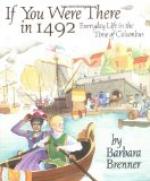Armed with these royal commissions, Columbus left the court for Palos; and we may be sure that the knot of friends at the monastery were sufficiently demonstrative in their delight at the scheme on which they had pinned their faith being fairly launched. There was no delay in furnishing the funds for the expedition. From an entry in an account-book belonging to the Bishopric of Palencia, it appears that one million one hundred and forty thousand maravedis were advanced by Santangel in May, 1492, “being the sum he lent for paying the caravels which their highnesses ordered to go as the armada to the Indies, and for paying Christopher Columbus, who goes in the said armada.” The town of Palos was ordered to provide two vessels.[11]
[Footnote 11: The requisition to the municipality of Palos runs thus: “In consequence of the offence which we received at your hands, you were condemned by our council to render us the service of two caravels, armed, at your own expense, for the space of twelve months, whenever and wherever it should be our pleasure to demand the same:” (30th April, 1492.) A proclamation of immunity from civil and criminal process to persons taking service in the expedition was issued at the same time. The ship of Columbus was, therefore, a refuge for criminals and runaway debtors, a cave of Adullam for the discontented and the desperate. To have to deal with such a community was not of the least of Columbus’s difficulties.]
Order to press men.
But there was still a weighty difficulty to be surmounted. It was no easy matter to obtain crews for such an expedition. The sovereigns issued an order authorizing Columbus to press men into the service, but still the numbers were incomplete, for the mariners of Palos held aloof, unwilling to risk their lives in what seemed to them the crazy project of a monomaniac. But Juan Perez was active in persuading men to embark. The Pinzons, rich men and skilful mariners of Palos, joined in the undertaking personally, and aided it with their money, and, by these united exertions, three vessels were manned with ninety mariners, and provisioned for a year.
Character of vessels and crews.
The vessels were all of small size, probably of not more than one hundred tons’ burden each, and, therefore, not larger than the American yachts, whose ocean race from New York to Cowes was regarded as an example of immense hardihood, even in the year 1867. But Columbus considered them very suitable for the undertaking. The Santa Maria, which Columbus himself commanded, was the only one of the three that was decked throughout. The official persons and the crew on board her were sixteen in number. The two other vessels were of the class called caravels, and were decked fore and aft, but not amidships, the stem and the stern being built so as to rise high out of the water. One of them, the “Pinta,” was manned by a crew of thirty, commanded by Martin Alonzo Pinzon. The other, the “Nina,” had Vincent Yanez Pinzon for captain, and a crew of twenty-four men. The whole number of adventurers amounted to a hundred and twenty persons, men of various nationalities, including, by the way, among them, two natives of the British Isles.




